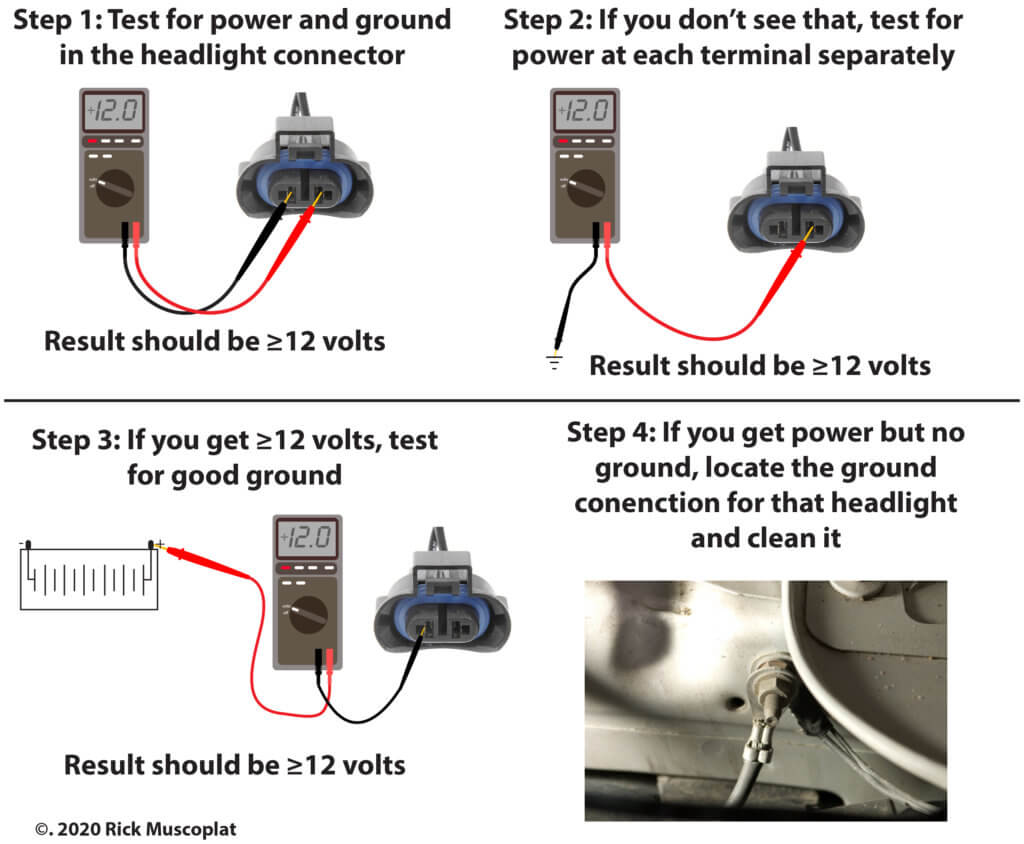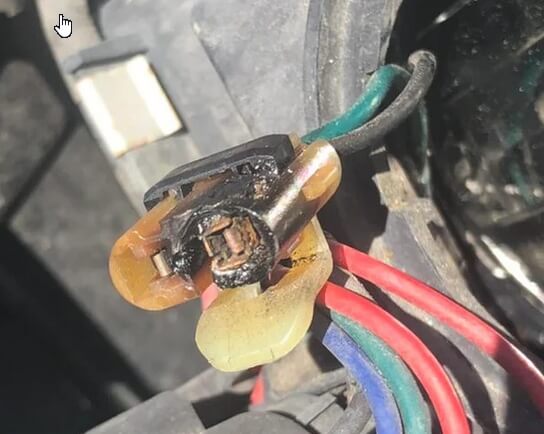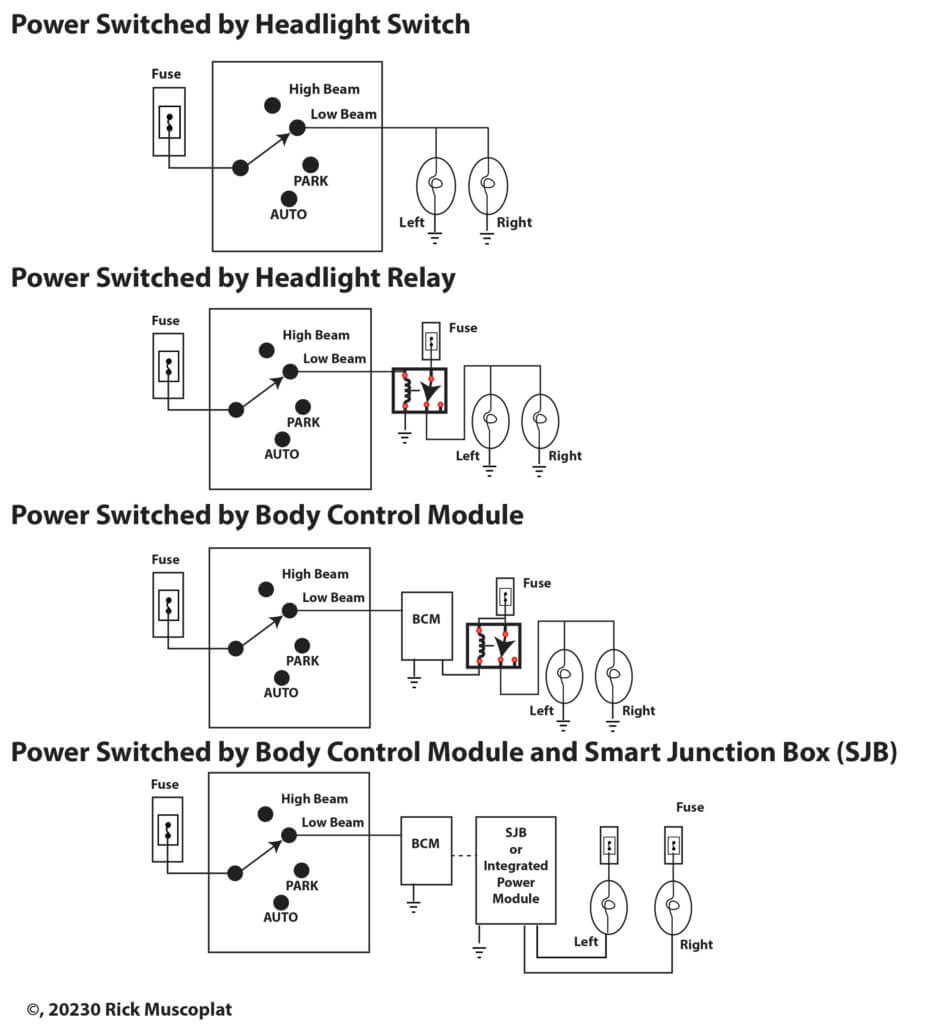Headlight doesn’t work with new bulb
Headlight doesn’t work with new bulb
What causes a headlight doesn’t work condition?
If your headlight doesn’t work with a new bulb, there are five possible causes:
Blown fuse
Damaged headlight connector or wiring harness issue
Inoperative headlight relay (if equipped) or faulty junction box
Faulty headlight switch
Body control module issue
Step 1 Check for power and ground in the headlight connector
Set your meter to DC volts. Turn on the low beams. On a 2-terminal connector, connect the probes the two terminals. If power and ground present, your meter will read +12 or -12 volts (indicating the polarity is reversed). Reversed polarity doesn’t really matter here; the fact that it’s reading +12 or -12 volts confirms that the socket is getting power and ground.

Step 2 If you don’t get power at the headlight connector
- Check the headlight fuse. There may be one or several headlight fuses, depending on the year, make and model
- Check the headlight connector condition

Check the headlight connector for:
Melting, corrosion, or terminals that have been pushed out the back of the connector. If you find any of those conditions, you’ll probably have to splice in a new headlight pigtail connector. Find a headlight pigtail at any auto parts store.
Melted headlight connectors are fairly common. The melting can be caused by excessive heat from the headlight bulb or undersized wiring from the factory. To prevent melting from re-occurring, splice in a new pigtail and then add a ceramic jumper. The ceramic jumper will handle the heat of the headlight bulb without melting. See this post for ceramic jumpers.
Step 3 Find out why you’re not getting power at the headlight connector
This is where it gets tricky. Here’s why.
- In older vehicles, the headlight switch actually switched power to the headlights.
- In later models, the headlight switch only provides power or ground to the headlight relay. It’s the relay that actually switches power to the headlights.
- In other variations on late-model vehicles, the headlight switch is only an input to the body control module. The headlight switch acts as a “headlight request,” asking the BCM to turn on the headlights. The BCM then provides either power or ground to the headlight relay(s).
- On the latest models, the headlight switch communicates with the BCM. The BCM communicates DIGITALLY with a smart junction box or an integrated power module (IPM). The SJB or IPM contains removable or permanently connected relays that switch either power or ground to the headlights.

You’ll need a wiring diagram to diagnose the headlight circuits on these models.
Here are some headlight troubleshooting tips:
• If your vehicle has an AUTO setting on the headlight switch, don’t use that setting for testing. Turn the headlight switch to LOW BEAMS. That will force the system to bypass the light sensor.
• If the vehicle has an AUTO setting, you’ll find a light sensor in the system. The light sensor is what the BCM relies on to know when to turn on the headlights. You MUST check out the signal from the light sensor to make sure the BCM is receiving the signal. If the BCM thinks it’s daylight, it won’t turn on the headlights automatically.
• If your vehicle has daytime running lights, the system often uses a DRL module to reduce voltage to the high beams. That extends their life. The DRL module often uses the light sensor, the shifter range selector and the parking brake switch to determine when to turn on the DRL.
• In vehicles with a BCM or IPM, the control module deciphers whether the driver is requesting parking lights, low beams or high beams based on the voltage drop. The BCM or IPM provides a reference voltage to the headlight switch and the headlight switches contain series wired resistors that drop the reference voltage by a set amount depending on the position. Based on the return voltage, the BCM or IPM determines what the request is and then turns on the requested lights.
• To test the headlight switch in these models, you’ll need a shop manual and wiring diagram showing the expected voltages. If you have a bi-directional scan tool, you can switch to live data and read whether the BCM is receiving the correct input from the headlight switch. If it’s not getting the right signal, you’ll have to manually test the headlight switch and wiring harness.
• Test for the reference voltage to the headlight switch. Then check for the return voltage. If it’s the expected voltage, then the problem is in the BCM or the relays.
• If the BCM IS receiving the proper signal from the headlight switch, then you’ll have to check the associated relays and wiring harness.
©, 2020 Rick Muscoplat
Posted on by Rick Muscoplat
